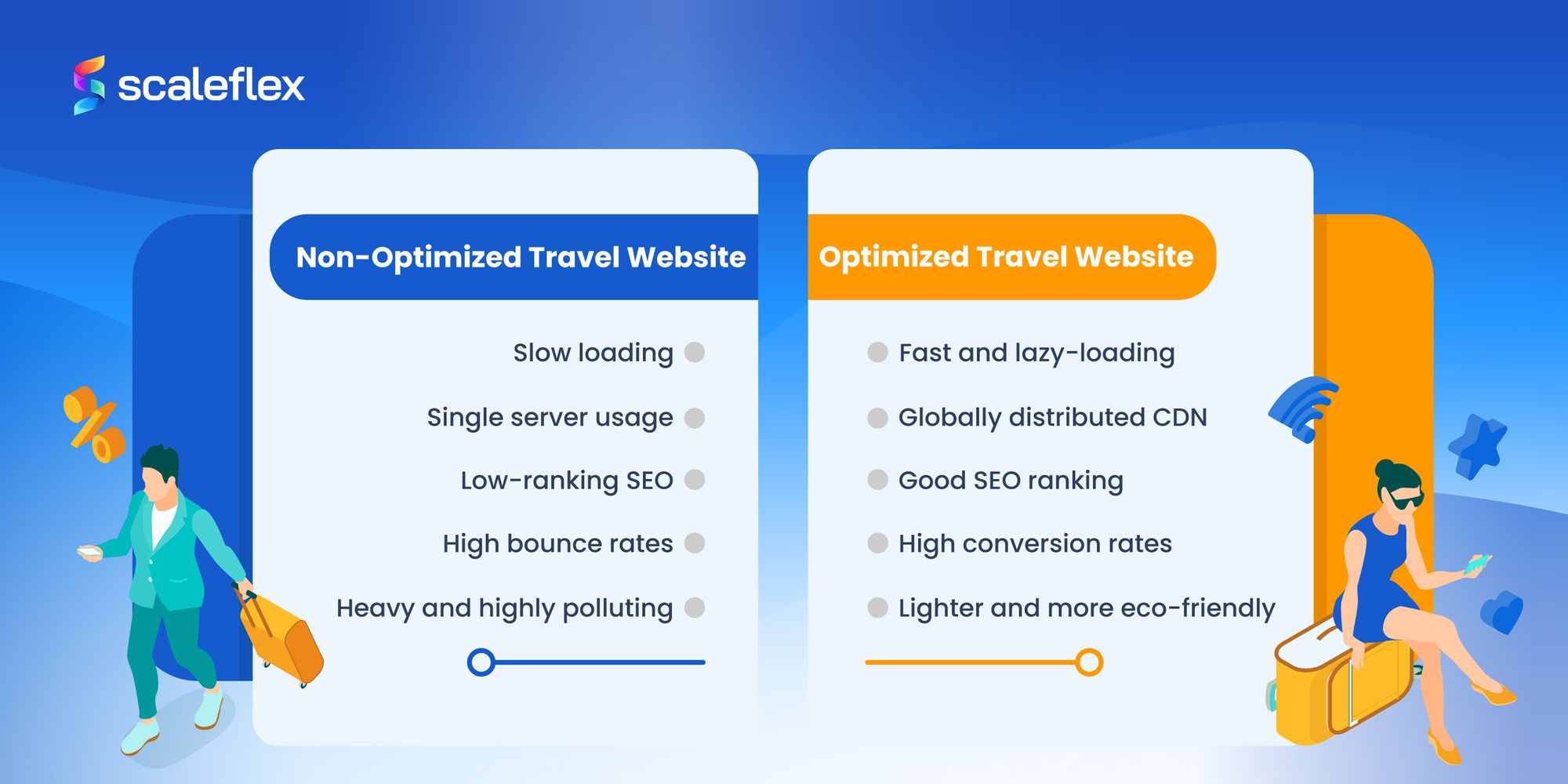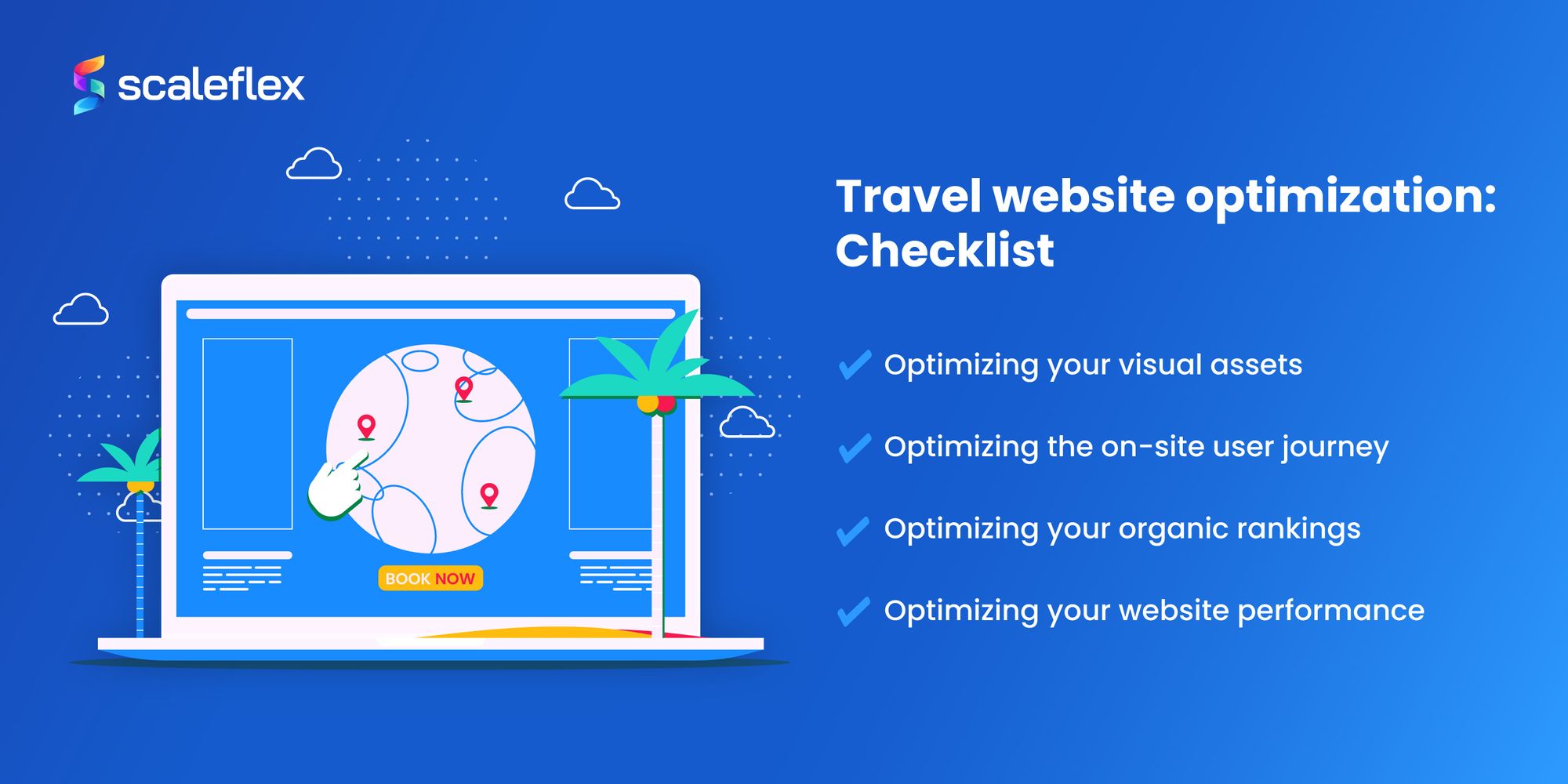Travel Website Optimization Checklist for a Visual-First Strategy
53% of users leave a site that takes longer than 3 seconds to load (Google data). With websites often being the first impression for a company, the user’s desire to stay engaged becomes more important than ever. The travel industry relies heavily on visual content to keep the potential customer captivated and engaged through storytelling and emotional appeal.
Well-selected, quality images guide the consumer towards their booking decision and improve their overall experience on your site. Image optimization and managing your digital assets play key roles in this first impression and beyond. However, if not properly optimized, high-quality images and videos can significantly slow down a website, leading to lost traffic and lower search engine rankings.
This article explores how to achieve efficient hotel website optimization, by underscoring the importance of optimizing the visuals for your website, improving user experience, and best practices for balancing visual quality with Search Engine Optimization (SEO) for travel websites to ensure fast, efficient, and engaging digital experiences.
Impact of visuals on travel website optimization
While visuals enhance engagement and storytelling, they can also impact key technical aspects of your website, such as page load speed and search engine rankings. Optimizing these elements is essential to maintaining both user experience and visibility.
Page load speed is crucial for retaining visitors on your travel website, as high-quality content and visuals, while essential for engagement and conversion, can slow performance if not optimized. Slow-loading pages frustrate users, increase bounce rates, and reduce booking potential, while even a one-second delay can impact engagement and revenue. Additionally, search engines factor in load speed when ranking sites, meaning unoptimized visuals can harm your SEO performance. To maintain both visual appeal and efficiency, travel websites must implement dynamic media optimization techniques that enhance speed without compromising quality.
Beyond user experience, Search Engine Optimization (SEO) is also directly affected by website performance. Google prioritizes fast-loading sites, and unoptimized images can slow load times, leading to a poorer user experience and lower rankings. As a result, websites that fail to correctly format their visuals risk becoming less visible to potential customers.

Focus areas for travel website optimization
There are four focus areas for optimizing travel and hotel websites, which we will discuss next.
Optimizing your visual assets
To maintain rapid loading speed within your website, it is essential to implement various optimization techniques such as image compression and adaptive format conversion.
Image compression reduces the file size of images while maintaining acceptable visual quality, helping travel websites load faster. There are two types: lossy compression, which reduces file size by removing some image data, and lossless compression, which retains all data but still optimizes the file. Travel companies can implement image compression using various tools or built-in Content Delivery Network (CDN) image optimization services. Additionally, Visual AI in the hospitality industry can automatically optimize and enhance images and videos. By compressing images before uploading them, you ensure high-quality visuals without sacrificing performance.
Beyond compression, choosing the right image format is equally important. Modern formats like WebP and AVIF offer superior compression compared to traditional JPEG or PNG files, reducing bandwidth usage while maintaining high-quality visuals. Many Image CDNs can automatically convert images to the most efficient format based on the user’s device and browser compatibility. By combining compression with adaptive formats, travel brands can deliver stunning visuals while keeping website performance optimized.
Optimizing the on-site user journey
Many factors drive visitors on your site to reserve, book, or rent. In this industry, Conversion Rate Optimization (CRO) is the process of optimizing your travel website by creating a pleasant website design and removing any obstacles that prevent potential clients from taking the next step, focusing more heavily on users who have already been attracted to your website. High-quality visuals that are correctly formatted play a key role in capturing attention and inspiring confidence without slowing loading speeds. A responsive design ensures that users have a smooth experience, while intuitive navigation and clear call-to-action buttons make it easy to complete their booking or request more information.
By balancing your compelling imagery with a visually engaging yet functional platform, your visitors will stay engaged and feel encouraged to finalize their travel plans.
Optimizing your organic rankings
Search Engine Optimization (SEO) is closely tied to website performance, and Google prioritizes fast-loading sites in its rankings. Because websites with unoptimized images load slower and user experience greatly decreases, search engines disfavor them, making it harder for potential customers to find your site.
Using alt text and structured data to properly describe your images for the search engine contributes to a better indexing of the content and results in more relevant search results. These are favored in the search engine’s algorithms and are essential in ensuring that your site ranks higher and attracts more organic traffic. By optimizing both the performance and the structure of your images, you can improve visibility and drive more users to your site.
Optimizing your website performance
A Content Delivery Network (CDN) for travel websites is essential for ensuring fast and seamless access to visuals, no matter where users are located. CDNs work by storing copies of website content, including images and videos, on multiple servers around the world. When a user visits the site, the content is loaded from the closest server rather than the main hosting server, significantly reducing load times.
To further improve your website’s performance, using the lazy loading web optimization technique delays the loading of visual content until they are needed, more specifically, when they appear on the user’s screen. This prevents the browser from loading all visuals at once, reducing initial page load times and improving website speed. Lazy loading is simple to implement and works well with Content Delivery Networks (CDNs), which optimize image delivery based on user location. By adopting this technique, you can provide a faster, more seamless browsing experience, improving engagement and reducing bounce rates.

Industry examples - companies leading the way
There are many success stories in the travel and tourism industries which highlight companies who have successfully managed their visual assets to maximize their impact and keep their loading times low, and their SEO high.
Booking Platforms
Major travel booking platforms like Expedia and Booking.com prioritize a fast, visually engaging experience by optimizing their images and videos. By using content delivery networks (CDN) and image-optimizing software, they are able to ensure consistent quality, building trust with users and boosting their website performance on search platforms.
Airline Websites
Global Airlines like Air France and Delta Airlines rely on Content Delivery Networks (CDNs) to ensure fast and seamless access to their websites worldwide. With thousands of daily visitors searching for flights, checking itineraries, and browsing promotional content, a slow-loading website would lead to frustration and lost bookings. CDNs help by distributing visual content across multiple servers worldwide, reducing latency and ensuring that images, videos, and booking pages load quickly regardless of the user's location. By integrating CDN technology, Delta and Air France enhance website speed, improve customer engagement, and ultimately drive more conversions through a smoother online booking process.
Key Takeaways for hotel website optimization
In the competitive travel industry, where websites are essential for making first impressions and keeping customer engagement, optimizing visual content is essential for keeping loading times fast and improving your customer experience. In a world where search engine rankings can make or break customer engagement, travel platforms must balance high-quality images and videos with fast loading times. Key strategies for optimization include compressing your images and adapting their formats, utilizing Content Delivery Networks (CDNs) to ensure fast, worldwide access, and using an Image CDN to ensure you’re using high-performing content on your site.
By implementing these techniques towards travel website optimization, you can ensure a faster, more engaging experience for visitors, ultimately improving their engagement and satisfaction. As the travel industry continues to prioritize digital experiences, the integration of CDNs and smart visual content strategies will remain a critical aspect of success.





